How to cook millet (lemon millet)
Updated: August 30, 2022, By Swasthi
Millet is one of the healthiest whole grains, apart from being gluten free it is also alkaline & packed with proteins and antioxidants. Consuming these in moderation is believed to be beneficial. At home we eat millets at least 2 to 3 times a week to make various dishes like lemon millet, khichdi, Pongal and many more. In this post I share with you all about millets and how to cook millet perfectly that’s fluffy and non-sticky every time.
What is millet?
For some folks, millet is just a treat for pet birds or livestock feed. For everyone else, millet is an edible seed that’s classified as a whole grain; it comes from the grass family Poaceae. Millet is popular in a variety of African and Asian cuisines, with many different kinds of millet from across the continents that bring all kinds of health benefits to diners’ tables.
Humans’ relationship with millet began nearly 10,000 years ago, where it was first cultivated in Asia and later West Africa and Europe. Millet wasn’t cultivated in the Americas until European colonists brought it over in the 18th century.
But what made it so popular?
This is one tough little cereal. Millets are annuals that finish their life cycle in one growing season, and many types of millets actually have fairly short growing seasons—proso millet only needs 60-80 days to ripen for harvest.
They’re also drought tolerant (meaning they can grow in arid environments with little water), require little to no fertilizer, and resist pests and diseases very well. Compounding these benefits is their nutrition, being rich in fiber, protein, vitamins, and minerals like potassium.
Being a quick-growing, low maintenance, nutritionally dense food crop led to its demand and spread across continents.
Kinds of millets
In India, millets are grown mostly for human consumption and sometimes they are also used as a bird seed or cattle feed. But in the United States they are either sold as bird seed or grown for hay to feed animals.
As the ancient grain gains more mainstream acknowledgement, different types of millet are showing up in grocery stores even in the US. Most grocery store millet will probably be Proso millet, foxtail millet, or pearl millet.
There are several kinds of millets eaten across the world: Here are some
Foxtail millet
Foxtail millet is well known as being one of the oldest cultivated species of millet. It is currently the second most widely planted millet and the most commonly grown in Asia. Other names for foxtail millet include German millet, Hungarian millet, Japanese millet, dwarf setaria, foxtail bristlegrass, and giant setaria.
Foxtail millet grains are similar in size to proso millet but have a wider range of colors, including black, white, red, yellow, and white. These are known as korralu in Telugu, navane in Kannada, thinai in Tamil & Rala, Kang or Kangh in Hindi.
We use this to make idli, dosa, khichdi, Pongal, lemon millet and curd millet. A lot of people use this like any other grain like rice or quinoa. It can be served with any curry. Foxtail millets are eaten in the ground and whole grain form.
Pearl millet
Pearl millet is the most widely cultivated of all the millets, with major centers of production being Africa and South Asia. It does very well in places with low soil fertility and water as well as high temperatures, making it a perfect food source for people living in dry or drought-prone regions.
While pearl millet is usually a forage crop in the United States, grain crop varieties are gaining popularity. The pearl-shaped grains are some of the largest among the millets, and range in color from white, grey, or pale yellow to brown, slate blue, or purple.
Pearl millet is known as bajra in Hindi, Kambu in Tamil and Sajjalu in Telugu. I have shared a pearl millet dosa recipe. You can also make millet khichdi with broken pearl millets. These are mostly not eaten in the whole form. They are either consumed in the form of semolina/broken millet or in ground and almost never eaten in the whole grain form.
Sorghum
Sorghum also known as great millet is another widely grown and used grain in India. It is known as Jowar in India. Traditionally these are used to make flatbreads/ roti known as jowar roti or bhakri. They are also popped and eaten like a snack. We also use jowar to make dosas and idli. You may check my recipes here – Jowar dosa, jowar upma and jowar pops.
You can easily find this in the form of – whole grains, broken jowar, jowar semolina (rava), jowar flour and pops.
Finger millet
Finger millet is widely known as Ragi or nachni in India. These are dark brown grains with the fiber and iron rich husk intact. These grains are milled to flour and used to make idli, dosas, roti, ragi mudde, and ragi malt. You will easily find the grains and the flour in Indian stores. These are mostly not eaten in the whole form.
Barnyard millet
Barnyard millet also known as little millet, are tiny and quick cooking kind which you only need to rinse and can also be soaked for a short period before cooking. These are known as Kuthiravali in Tamil, Jhangora in Hindi and oodalu in Telugu
Little millet
Little millet also known as sama/kutki in Hindi, samai in Tamil, and samalu in Telugu. These are mostly and always eaten in the whole form like rice or quinoa.
Proso millet
Proso millet is one of the oldest kinds of cultivated millet. Also called common millet, broomcorn millet, white millet, red millet, and hog millet, it’s one of the few millets not usually grown in Africa.
Its short growing season and low upkeep make it popular among farmers for both human and animal consumption. The seeds are typically white, yellow, or brown, though red varieties are available.
Kodo millet
Kodo millet is another kind of millet and are known as Arikelu in Telugu and Varagu in Tamil, Harka in kannada and kodra/koden in Hindi.
To make this lemon millet, I have used kodo millet. However you can also use foxtail millet, little millet or barnyard millet.
Preparing millets
These days millets sold in grocery stores are mostly hulled. Though these can be straight away rinsed and cooked, soaking them helps to reduce the phytic acid which impairs the absorption of nutrients.
So it is highly recommended to soak millets for the recommended amount of time. Also soaking helps to cook the grains faster.
Again soaking time differs for each kind of millet. For example, foxtail millet is best soaked for 6 to 8 hours before cooking.
The most uncommon way is to toast the millets, soak and then cook. This toasting method works well for little millet, proso millet and barnyard millet. Though I don’t see any difference in the flavor or taste when toasted.
However if using millets in the ground form (flour) then it can be used straight away without soaking, to make crepes, pancakes, breads, flatbreads or cookies.
With the following instructions you can cook proso millet, kodo millet, little millet and barnyard millet.
Photo Guide
How to cook millet (step-by-step photos)
There are a couple of different ways to cook millet. The first and most basic way is to boil and steam millet, almost like rice. The cook time and the quantity of water to use depends on the kind of millets used. Again it is different for every brand & also depends on the harvest date.
So you may also want to check the instructions on the pack.
1. Add millets to a large pot and rinse them well a few times rubbing with your fingers. Here I have used kodo millet. I prefer to soak them for 30 mins as they cook faster and lighter to digest. You can cook proso millet, little millet and barnyard millet the same way. It is optional and you can skip it too.
2. Open pan/ pot method: 1:3 ratio works well for me. Add water along with salt to the pot and cook them on a medium flame until the water is absorbed. When there is little moisture, cover and cook on the lowest flame until soft and tender. Fluff up gently with a fork. Cool this completely.
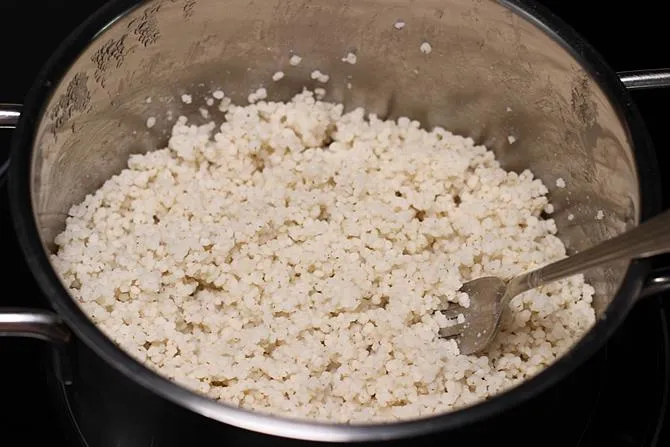
How to make lemon millet
3. First heat oil in a pan. Add mustard and allow to splutter. Add chana dal, urad dal, red chili and green chili. If you do not prefer heat from the green chili add it later with ginger.
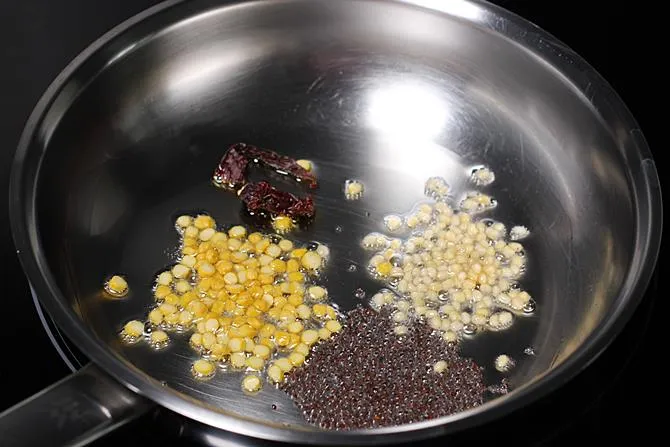
4. Add cashews and fry all until the dals turn golden.
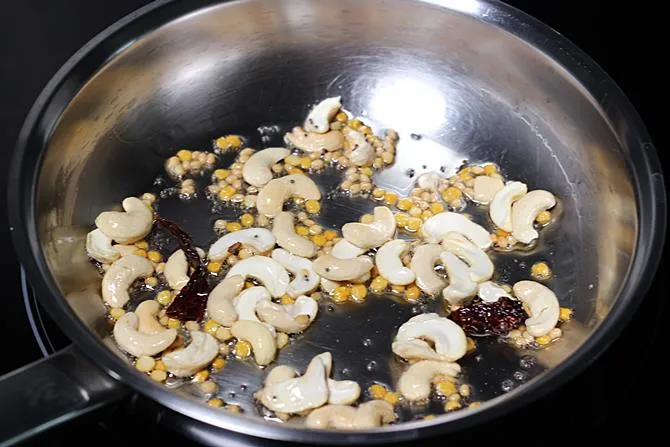
5. Add curry leaves, ginger and green chili if you have not added earlier. Saute for a minute until the leaves turn crisp.
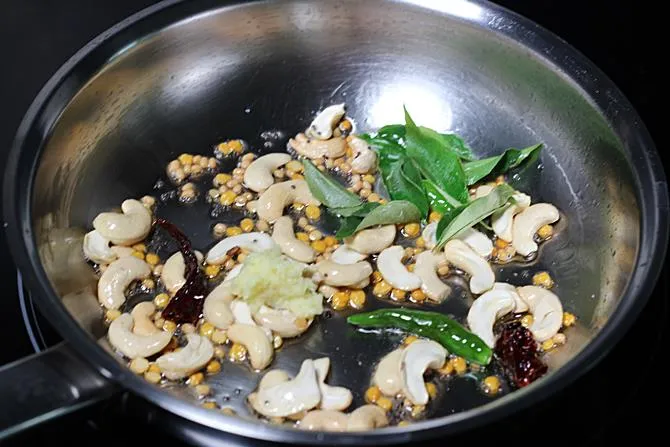
6. Add hing and turmeric. Pour 3 to 4 tablespoons water and cook until all the water evaporates. This will bring out the aroma of the spices and soften the dal slightly. If you want more softer dals, then you can 1 to 2 tbsps more water.
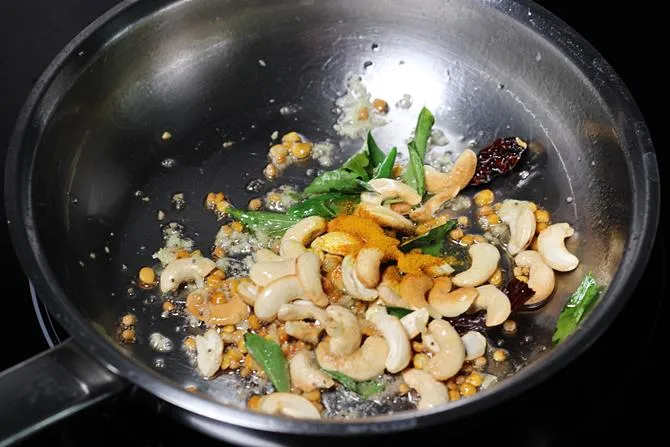
7. Turn off the heat. Add the cooled millets and squeeze in lemon juice.
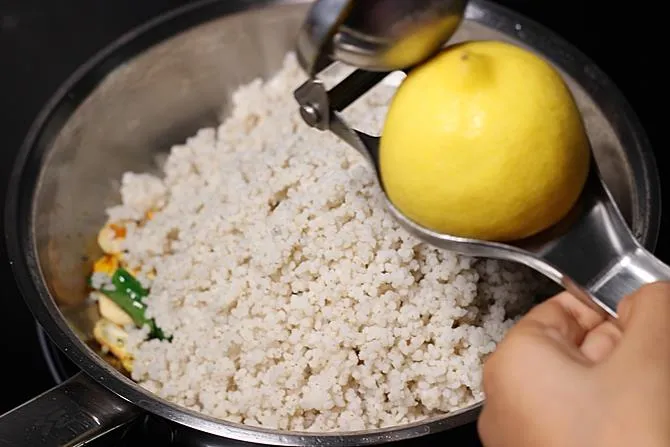
8. Lastly mix everything well.
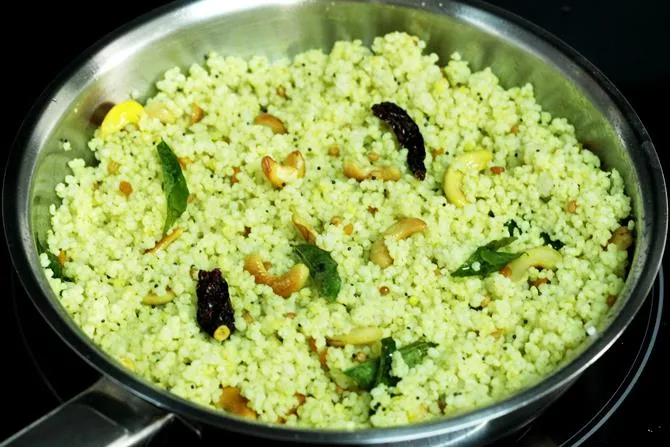
Serve lemon millet with curd, pickle, papad or vegetable salad.
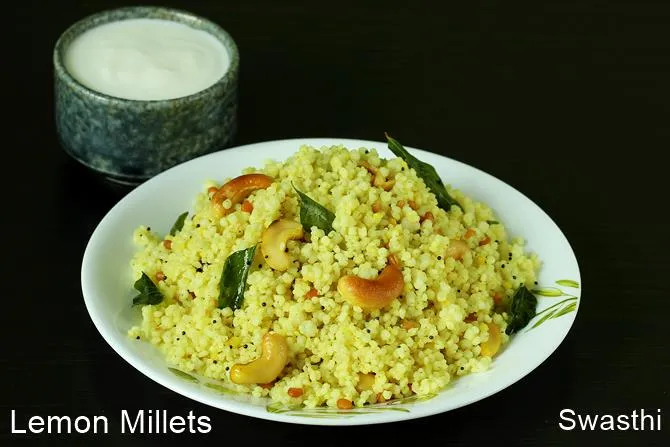
For more similar recipes,
One pot Millet khichdi
Recipe card
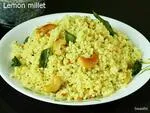
How to cook Millet (Lemon Millet)
For best results follow the step-by-step photos above the recipe card
Ingredients (US cup = 240ml )
- ½ cup millet kodo millet/ varagu / arikelu
- 1½ cups water
- Salt as needed
- 1 ½ tbsp oil (use as needed)
- ½ tsp mustard seeds
- 1 to 1 ½ tbsp bengal gram (chana dal)
- 1 to 1 ½ tbsp skinned black gram (urad dal)
- ¼ cup peanuts or cashews split (use as needed)
- 1 pinch asafoetida (hing )
- 1 green chili slit
- 1 red chilli broken
- 1/8 tsp turmeric
- 1 tsp ginger grated
- 1 sprig curry leaves
- 1 lemon Medium to large (use as needed)
Instructions
How to cook millet
- Add ½ cup millets to a pot and wash thoroughly. Drain completely. Add 1 ½ cups water, salt as needed to the pot and allow to soak for a while. You can also skip soaking.
- Cook them on a medium flame until all the water is absorbed, but slightly soggy. Cover the pot and simmer on the lowest heat until completely cooked. Fluff gently with a fork and cool completely.
How to make lemon millet
- Heat a pan with oil. Add mustard when they begin to splutter, add chana dal, urad dal, cashews and red chili, green chili.
- When the dals turn slightly golden, add curry leaves, ginger and green chili.
- Curry leaves turn crisp very soon. Then add turmeric and hing. Pour 3 to 4 tablespoons water and cook until all of the water evaporates. This will soften the dals and bring out the aroma of spices. Turn off the heat.
- Add the cooled millets and squeeze in the lemon juice. Mix everything well.
- Serve lemon millet rice with curd, veg sald, papad or pickle.
NUTRITION INFO (estimation only)
© Swasthi’s Recipes
About Swasthi
I’m Swasthi Shreekanth, the recipe developer, food photographer & food writer behind Swasthi’s Recipes. My aim is to help you cook great Indian food with my time-tested recipes. After 2 decades of experience in practical Indian cooking I started this blog to help people cook better & more often at home. Whether you are a novice or an experienced cook I am sure Swasthi’s Recipes will assist you to enhance your cooking skills. More about me
Follow Swasthi’s Recipes

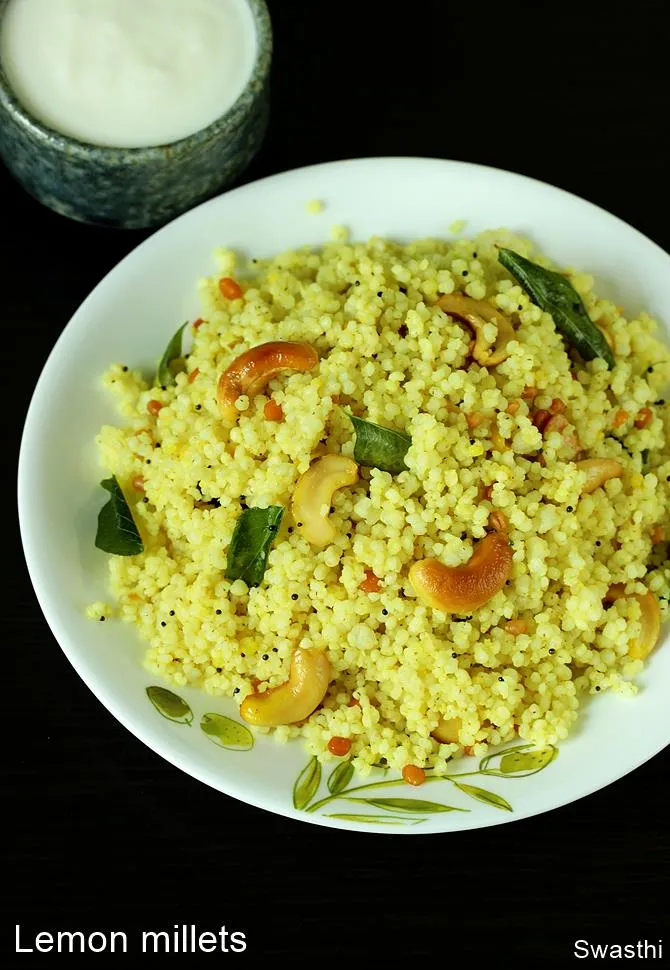
Comments
Your recipes are always awesome and you encourage me to cook healthy indian food this recipe also no exception
Ishita, Thank you so much!
Loved all the info. I am a reversed diabetic looking for easy millet and other healthy low carb or fibre rich foods to suit diabetics. I want to retain my low HbA1C of 5.1 as best possible. Any help is deeply appreciated. I am also recently single, a widower not quite used to cooking. Simple health is my goal.
Thank you! That sounds very inspiring and please let us know if you want more information on cooking with millets. I would be happy to share.
Hi, You say that pearl millets and also some other millets should never be eaten in whole form. What does it mean? Are the grains which we buy from health shops “whole forms”? Whats the difference to split ?
Hi Girish,
The whole form/ grains have a outer covering (not bran) which needs to be removed and processed. These days what we buy from the stores is already removed unless you buy from farmers markets. Yes what we buy in the health shops are ready to cook. There may be some fiber loss in the split version but they cook faster and can be used in dishes like upma.
lovely. great dish.
Thanks for the foxtail recipe. I shall try and m sure it will turn out to be good. How about adding onion to it and some mix veggies? Won’t it be much tasty? Please comment.
Yes you can add onions and veggies. This recipe is made the traditional south Indian way without all those. But yes I do add them a lot of times. I also have another millet lentil and mix veggie khichdi here – millet khichdi
I could not find Kodo millet but did find Little Millet at an Indian grocery (U.S.A.) and fresh Curry leaves. The Little Millet cooks just like the one in this recipe. This recipe is excellent ! Thank you! I made two servings, prepared the spices first in my stovetop pressure cooker (held the cashews until the very end) and then added the millet (after the 15 minute soak) with the appropriate water, cooked at pressure for 25 minutes and it came out perfect.
I am making the Palak Curry next!
Madam/ Sir your receips are so good
Shall we cook in cooker millets
Please reply me madam/sir
Hi,
Yes you can cook in cooker but the cook time is different for each kind of millets. You may check this Millet khichdi recipe made in cooker
U are amazing ????
Just loved the recipe
Thank you!
Hello! Glad to have stumbled upon your page and go through so much detail. Very well explained!!
If I want to swap foxtail millet here, only the soaking time will change and rest will remain the same?? And can millet upma be made using same process?
Thank you :))
Mouth Watering
How in the world can there be 23 grams of fat in this?
I rechecked for you and yes it is. The fats come from oil and peanuts.
Looks very nicely. Thanks for sharing.
These all sound delicious! I am keen to use more millet for the family. The Lemon millet recipe says add China dal or urid dal – is this pre cooked dal? Or soaked at all?
Thanks for your help. ?
Hello Tracey
They are not precooked. They are partially cooked in the pan itself to retain their crunch. If you prefer softer dal then you may soak them in hot water for 15 mins. Drain the water and add them here to the tempering.Hope this helps
Very nice recipie. I tried. It tasted nice. Thanks a lot SWASTHI
Welcome Savi
Glad you liked it!
Thank you!
Nice recipe..Will try asap.
Thank you! Yes do try it!
Want to get knowledge for healthy recipes
Hi Swasthi My name is Kala
I am from S Africa.I was recently in India and was advised to get these millets I did not know how to prepare these and am glad i stumbled on your blog
Both my brother and I are diabetics
And cant wait to try out yr recipes
Do u do diet plans for diabetics
We both are in our seventies
Hi Mrs.Kala,
Glad to know you. I don’t make diet plans. If you need any particular recipe I can help you with it. We have been eating whole grains including millets for over 10 years now. So I can suggest you about the recipes.Hope this helps.
For diabetic patients ragi biscuits is good for health and ensure diabetic powder is good.try it
As per kadher sir,It is good to soak millet atleast 4hrs before cooking.please do consider.as it is millet grain it might be hard to digest and may not get full benefits without soaking.
Hi Aswani,
Yes Any other millets need to be soaked well for several hours but not hulled kodo millet. You will be left with a mush if you soak hulled kodo millet for 4 hours. These are also very alkaline in nature so they will not cause any digestive problem. We eat them at least 3 to 4 times a week with no issues.
thanks.
Dear Swasthi,
Hope you are doing well.
Recently I visited your blog, I liked it. Very good receipes.
Could you please tell me, whether we can provide Millets to diabetes patient. How many times they can take Millet in a week.
Many thanks.
Best Regards,
Kalai
H Kalaimathi,
You are welcome. I am doing good. Thank you. Yes millets can be consumed by diabetics if they do not have thyroid problems. Millets can be eaten about 4 to 5 times in a week not only by diabetic ppl but everyone can. Hope this helps.
🙂
Hi Swati
I tried to make Kichadi with Fox Tail millet, the millet was soaked for more than 15 hours, but it still has the husk,
what did I do wrong
Hi Suman,
I think you got the wrong foxtail millet. There are 2 kinds – with and without husk. Millets in the husk are actually soaked, drained and pound lightly to remove the skin before cooking. Your’s has the husk and they need to be removed.
I m a big fan of ur blog I tried so many recipes from ur recipes list. It’s really helping me to try so many new recipes. Thank u so much for giving this blog.
Welcome Kalpana
Thanks a lot for the comment. So glad to know the recipes are useful.
🙂